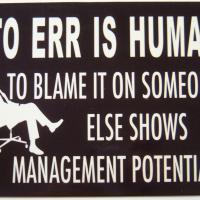
To Err is Human, Part 4
It is well known fact that we learn the most from the games that we lost. But you need to analyze all of your games because sometimes a draw can teach you more than a bunch of losses. I want to present two draws that definitely helped me to understand some of my shortcomings.
The next game was played in the Soviet Junior championship. I sacrificed some material, got a very promising attacking position but couldn't find a decisive finish. Just look at the position shown in the diagram.
I felt that White's attack must be too strong for Black to survive. I was looking for the forced line to checkmate my opponent and couldn't find it! Finally, when I was down to the last 10 minutes, I decided to force a draw by perpetual check. When the game was over, somebody asked me if I could lift the Rook by playing 23. Re1 and then 24. Re3. At first I thought that the guy was insane. I am down a whole Rook and he suggested to calmly move my Rook? But the more we looked at the position the clearer it became to me that it was a very strong idea that would probably win the game. Moreover, later we established that White could've played 23. f4! with the same idea of the Rook lift (Rf3) but also cutting off the Black Bd6, so my Rooks has the g3 square available. I don't remember all the variations, but it is not important at all. The main point was that I didn't even consider those moves because being down a lot of material I thought that if I don't deliver a forced checkmate right away I will lose the game for sure.
It was a very painful lesson since the game was played in the penultimate round and a win would have seriously improved my tournament situation. Besides Vassily Ivanchuk was considered a rising star of Soviet chess, and it is always nice to beat a very strong opponent in style. But a painful lesson is usually very good for your chess improvement. After that tournament was over, I worked a lot on the games played by the great attacking players (mostly Tal) and later couldn't even believe how could I miss the idea of the Rook lift and why I basically panicked being a Rook down but having a great attack. I think that if I hadn't play this 'ruined gem', I wouldn't have played the game against Nikolaidis, which is definitely the best I ever played. I already presented this game here:
The next game was also very important for me since it was played towards the finish of the US Championship and both opponents were among the leaders. When we reached the position in the diagram I couldn't understand why my opponent kept playing since it was obviously a dead draw. I didn't offer a draw since I thought if my opponent keeps playing he has a reason and when he decides that there is nothing left on the board to play, he will offer a draw himself. So basically I was waiting for my opponent to come to his senses and offer me a draw.
I cannot really explain what happened next. I was playing reasonable-looking moves until I found myself on the verge of defeat! Fortunately, I still had some time left on my clock and found the only way to save the game. Can you find it?
This game made me think. I would never consider to keep playing in that 'dead drawn' position. And yet Black continued the game and was very close to winning. In this game Nakamura didn't get anything in return for his great effort, but how many extra points and half points did he collect in his chess career thanks to this attitude? This fighting spirit definitely helped him to win that US Championship! Meanwhile I looked at my own games and saw that in many games I didn't even try, believing that since it is a draw, why waste time? Like, for example in the next game:
In the position in the diagram my opponent offered me a draw and I accepted it. Indeed the endgame is drawish and why waste time against a strong opponent, right? But after the lesson I got from Nakamura, I think it was my mistake and I should have kept playing. Could I lose that game? Absolutely! I am not even sure if White is better there. But that's what real fighters should do!
Fortunately, I had the opportunity to use the lesson from Nakamura just a couple of months after that game!
Again the position in the diagram looks like a dead draw which is not worth playing, but now I know better!
I hope that after reading this series of articles about the importance of working on your chess mistakes, you will get out the notebook with your chess games and start looking for your mistakes and the ways to fix them.
Good luck!






